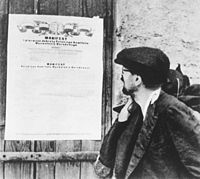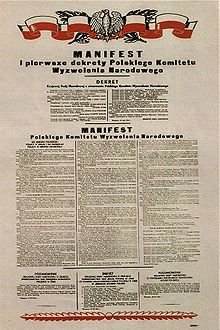- Polish Committee of National Liberation
-
 A propaganda photo of a citizen reading the PKWN Manifesto, issued on July 22, 1944
A propaganda photo of a citizen reading the PKWN Manifesto, issued on July 22, 1944
The Polish Committee of National Liberation (Polish Polski Komitet Wyzwolenia Narodowego, PKWN), also known as the Lublin Committee, was a provisional government of Poland, officially proclaimed 21 July 1944 in Chełm under the direction of State National Council (Krajowa Rada Narodowa, or KRN) in opposition to the Polish government in exile. It exercised control over Polish territory re-taken from Nazi Germany and was fully sponsored and controlled by the Soviet Union.
On 22 July 1944 the Manifesto of the Polish Committee of National Liberation was published, announcing radical social, political and economic reform, continuation of the fight against Nazi Germany, nationalisation of industry and a "decent border in the West". It also proclaimed the PKWN to be "the only legitimate Polish government", thus formally rejecting the Polish government in exile. Soon afterwards, the Soviet Union started to transfer power in the Soviet-controlled areas of Lublin, Białystok, Rzeszów and Warsaw Voivodships to the PKWN. Actual control over those areas remained in the hands of the NKVD and the Red Army, however. Beginning August 1, 1944, the Committee was officially headquartered in Lublin. Nikolai Bulganin represented Soviet administration.
Among the members of the PKWN were politicians of various communist and leftist parties accepted by Soviet authorities. Its chairman was Edward Osóbka-Morawski (Polish Socialist Party, Polska Partia Socjalistyczna, or PPS). His deputies were Wanda Wasilewska (Union of Polish Patriots, Związek Patriotów Polskich, or ZPP) and Andrzej Witos (People's Political Party, SL), a younger brother of Wincenty Witos, a notable pre-war politician. Andrzej Witos was later replaced by Stanisław Janusz.
 The PKWN Manifesto, issued on July 22, 1944
The PKWN Manifesto, issued on July 22, 1944
Other members included those from KRN, ZPP, Worker's Party of Polish Socialists (RPPS), SL, Democratic Party (SD), Polish Workers' Party (PPR) and unaffiliated. Most of these organisations and politicians were largely unknown to Polish society.
On 31 December 1944, the PKWN was joined by several members of the Polish government in exile, among them Stanisław Mikołajczyk[citation needed]. In January 1945, after the Soviet Union entered Warsaw, it was then transformed into the Provisional Government of the Republic of Poland (Polish: Rząd Tymczasowy Rzeczypospolitej Polskiej, RTRP) that was to govern the areas taken by the Red Army from Nazi Germany until the elections were held.
International reactions
The creation of the Polish Committee of National Liberation was part of Joseph Stalin's attempt to create a situation that could not be undone in Eastern Europe before negotiations with its allies. This heightened the tension between the Soviet Union and the other members of the United Nations which would eventually lead to the Cold War.
Similar events took place in many of the other East European states under control of the Red Army, as, for example, in Romania in March, 1945, where a Communist government was elected through a combination of vote manipulation, elimination and forced mergers of competing parties.
The future Western Bloc allies saw these events with great distress, especially because Stalin had previously accepted the Atlantic Charter in principle, signed it at the Yalta Conference, promised to hold democratic elections in the countries controlled by the Red Army and signed the "Declaration about the Liberated Europe".
See also
- Provisional Government of the Republic of Poland (Rząd Tymczasowy Rzeczypospolitej Polskiej or RTRP) - 1945
- Provisional Government of National Unity (Tymczasowy Rząd Jedności Narodowej or TRJN)- 1945/47
- Peoples' Army of Poland (Ludowe Wojsko Polskie or LWP)
- Polish government-in-exile
- Eastern Bloc
References
- Davies, Norman, 1982 and several reprints. God's Playground. 2 vols. New York: Columbia Univ. Press. ISBN 0-231-05353-3 and ISBN 0-231-05351-7
- Żenczykowski, Tadeusz, Polska Lubelska 1944. Editions Spotkania, Warszawa 1990.
- Mission to Moscow, Time, Aug. 7, 1944
Categories:- 1944 in Poland
- Cold War
- Government of Poland
- History of Poland (1939–1945)
- Poland–Soviet Union relations
- Political history of Poland
- Stalinism in Poland
Wikimedia Foundation. 2010.
